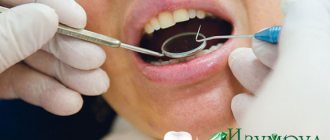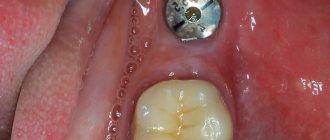Tooth nerve and need for removal
A tooth is not just a bone. In its roots there is a living pulp - blood vessels with nerve endings. This pulp is called the dental nerve; with its help, the tooth senses heat or cold. If the pulp is removed, the tooth dies, is not supplied with blood, is easily destroyed, and is less resistant to influence.
If a tooth is affected by caries, at first the destruction involves only dentin, the durable tissue of the tooth. But if caries is not treated in a timely manner, it will reach the pulp and pulpitis will begin. Then the pulp has to be removed - completely or partially, and if the pulpitis has reached periodontitis, the pulp has to be completely amputated. The nerve is also removed in case of mechanical destruction or prolonged pain.
How to kill the pulp in dentistry
A dental procedure is performed under anesthesia, regardless of the nature and scope of the work. The specialist knows why there are nerves in teeth, so he selects an anesthetic taking into account the anatomical features, the patient’s possible allergic reaction and individual wishes. The depulpation process is as follows:
- Removal of dentin and enamel with anesthesia. The procedure is carried out using air cooling technology.
- Placing a special paste that allows you to kill the nerve of the tooth, both the canine and the molar. Today, modern pastes are used to devitalize nerve endings.
- Installation of a temporary filling.
- Removal of temporary filling, opening of the pulp chamber, extraction of nerve endings.
- Canal cleaning, disinfection, filling.
At the final stage, a control x-ray is taken, where the patient and the doctor can see how the canals were sealed. After the procedure, the question may arise about how to relieve toothache even though the nerve has already been removed. For this you can use drugs such as Ibuprofen, Pentalgin, Nimesil. It is recommended to use only those products prescribed by the dentist. After treatment for pulpitis, pain may be observed for a week.
Removal with arsenic
Once upon a time there was only one way to remove it, it was terribly painful, especially since you had to visit the doctor several times. At first, the doctor drilled the tooth down to the pulp with a drill, which was extremely painful. Next, arsenic was placed in the hole and it was temporarily sealed with a filling. In a couple of days, the arsenic dealt with the nerve, and the tooth hurt so much that no medicine could help. Then I had to go to the doctor again, he opened the temporary filling, removed the nerve, and cleaned the root canals. Pulp is a tenacious substance, so this process was also extremely painful.
This technology poses a certain danger, because arsenic is a poison, and the doctor, when using it, must be especially careful, and the patient must be careful: if you are late with the second visit to the doctor and leave arsenic in the tooth, it will completely destroy it, which will end deletion. Dentists stopped using arsenic and developed new techniques for removing pulp.
Arsenic in the tooth: what to do if it still hurts?
Arsenic in dentistry is used to reliably kill the diseased nerve of the tooth. This technique has long been known and is slowly giving way to modern methods of anesthesiology. However, modern specialists still often practice the use of arsenic.
Arsenic in the tooth: the tooth hurts, you need to block the pain
In diseases such as caries, pulpitis or periodontitis, the inflamed dental nerve causes severe pain. In order to “kill” the diseased nerve, a special arsenic paste is used, the dosage of which is calculated individually for each patient. After putting the paste into the affected tooth, the doctor sets the time for the next appointment, which cannot be postponed. You can walk around with arsenic in your tooth for no more than three days!
What to do if there is arsenic in the tooth, but the tooth still hurts?
As a rule, arsenic quite quickly carries out the process of necrotization of the pulp, and the tooth stops hurting. But it also happens that there is arsenic in the tooth, but it still hurts. Most often, the pain after placing a temporary filling with arsenic subsides gradually over one to two days. If, after this period, the tooth continues to hurt, this can be caused by various reasons:
- pain is your body's reaction to the drug;
- temporary filling has an irritating effect;
- the doctor has chosen the wrong dosage of the drug for you;
- the medicine was installed incorrectly;
- osteonecrosis has occurred;
- the inflammation process has gone beyond the pulp.
In any of the indicated cases, you should immediately consult a doctor, because tooth pain that does not stop after arsenic is present is a very alarming sign.
What to do as first aid before you visit the dentist?
In order to relieve pain, we advise you to take some anti-inflammatory non-steroidal drug. For example, diclofenac, nurofen, ibuprofen, etc. Ordinary analgin can also help. Do not self-medicate under any circumstances - do not rinse the sore tooth with warm solutions and do not apply heat to the sore spot. If the pain is unbearable, and there is still a long time before visiting a doctor, you can try to remove the medicine yourself, but under no circumstances swallow or chew it, and after removing it, rinse your mouth thoroughly.
You can get a consultation at the DENTISTRY clinic. Make an appointment by calling +7 (8342) 308–088 or using the form below.
Make an appointment
Modern pulp removal
Today, it is enough to go to the dentist once to remove the pulp. The doctor gives an anesthetic injection and calmly works with the tooth, removing the destroyed layer of dentin, extracting the pulp, treating and filling the canal. Sometimes inspection using a microscope is possible. To be on the safe side, your doctor may place a filling temporarily to make sure he has completely removed the pulp. And only if everything turns out to be in order, the final filling is installed.
Incomplete removal of the pulp is also possible, which makes sense if only the outer part of the pulp is affected by inflammation. Dead tissue is removed from the opened tooth, the outermost part of the pulp is removed, and the root remains intact. This is especially important on children's teeth, since the pulp is responsible for the formation of roots. When the pulp is not completely removed, the tooth is kept alive, and further destruction occurs more slowly.
How to remove the nerve of a tooth today
Today it has become possible to remove the dental nerve by visiting the dentist just once. Depending on the diagnosis, the nerve is removed completely or partially.
- Complete removal. It is performed under anesthesia. After an anesthetic injection, the doctor removes the affected dental tissue and extracts the pulp with a special tool. The procedure lasts on average half an hour. If the depulpation process was controlled using a microscope, the dental canals and the tooth itself are thoroughly filled after the procedure. Sometimes the dentist first places a temporary filling, and then, after making sure that the procedure was completed successfully, changes it to a permanent one.
- Partial removal. It is carried out when only the coronal part of the pulp is affected. The root is preserved, and the inflamed tissue is removed. If the nerve is partially amputated, tooth decay does not occur as quickly. Therefore, this method is recommended for carious disease of molars in children.
Why does a tooth from which the nerve has been removed hurt?
Patients often complain that the tooth from which the nerve was removed continues to hurt. This is a completely natural pain, the result of intervention in the body. In a couple of days the pain will go away. It can be observed when clenching teeth, when reacting to hot and cold. To reduce discomfort, take analgesic medications.
But if, due to improper treatment, the nerve was not completely removed, the pain and inflammation will return. It is possible that the canals were poorly treated, and there may also be an allergy to the filling material. It is necessary to go to the doctor immediately, since advanced inflammation can lead to tooth loss.
The tooth from which the nerve has been removed becomes dead, but it still remains and is not lost, so if you have a toothache, immediately go to the dentist. There is nothing to be afraid of - modern treatment is painless, and after it your diseased tooth will serve you for many years to come.
Will my tooth hurt after pulpitis treatment?
The effect of the anesthetic drug wears off approximately 3 to 4 hours after the injection. The tooth sometimes begins to ache monotonously, and this pain can continue for some time. My tooth made itself felt for about two days. I stopped chewing on the left side of my jaw for several days to avoid getting hard food particles on the filled tooth, because at such moments the pain worsened significantly. These days I measured my body temperature, monitored my well-being, and was wary of complications.
My condition completely stabilized on the fourth day. I got used to the new filling, and the cured tooth stopped hurting. Now all I had to do was carefully monitor the health of my teeth and do everything to prevent deep inflammatory processes that lead to the removal of the nerve.
Surgery to remove a nerve frightens patients more with the unknown than it actually causes pain and discomfort. Toothache tends to be insidious and appear unnoticed, so I recommend everyone not to start inflammatory processes in the oral cavity, consult a dentist in time and not let the matter go to the point of removing the nerve. If indications for removal still appear, feel free to go to a professional and competent doctor. The doctor will select a good anesthetic for you, treat your aching tooth and relieve the pain forever.
Why arsenic in dentistry
The use of arsenic is not very common now; modern treatment is carried out with arsenic-free pastes that contain an analgesic. After this paste is applied to the nerve, it should remain for several days. Throughout this period, the crown does not hurt, the nerve gradually dies, then it is also painlessly removed.
In case of severe carious destruction of the crown or in cases of pulpitis, the dentist will perform depulpation.
The dental nerve will be removed with arsenic in the following cases:
- contraindications to anesthesia, allergies to painkillers;
- characteristics of the body when existing anesthetics do not work;
- emergency dental treatment.
Arsenic cannot be used for treatment in the following cases:
- age up to 2 years;
- arsenic intolerance;
- poor access to the dental cavity;
- root disconnection;
- increased intraocular pressure;
- tooth root disease;
- systemic diseases of the genitourinary system.
Paste with or without arsenic is used only when pain relief cannot be performed. As soon as arsenic is added and a temporary filling is placed, the dental nerve begins to gradually die, causing the organ to hurt for some time, it may be painful to press on it and it reacts to temperature stimuli. After applying the arsenic paste, it should remain in the tooth for 24 to 48 hours.
If for some reason you cannot visit the dentist after the specified time to remove the nerve, complications may arise, even to the point where you will have to have the crown removed. To prevent this, you need to properly plan the treatment and do everything according to the dentist’s instructions.
What is pulp?
The pulp, or dental nerve, is a bundle of nerve endings and capillaries in the internal cavity of the tooth. It is protected from external irritants and infection by the tissue that is located in the root and crown.
After removal of the nerve, the blood supply and mineralization of the tooth deteriorate significantly. In addition, its sensitivity decreases, the enamel becomes dull and weakens. In other words, pulp removal negatively affects the structure and strength of the tooth, but makes it possible to preserve it.
Indications for the procedure:
- exposure of the nerve as a result of tooth trauma and damage to the crown;
- consequences of improper dental treatment;
- the presence of caries-affected tissues;
- preparation for prosthetics;
- chronic inflammation of the pulp (pulpitis);
- inflammation of the root membrane of the tooth (periodontitis);
- low placement of crowns;
- extensive pulp area;
- bactericidal infection of the apex of the tooth root.
How long can you walk with an exposed pulp, and for how long do you put arsenic in your tooth?
To reach the pulp zone you need to get close to it. This happens most often when patients come with complaints of severe pain. They are like a sharp piercing electric shock. The response time is very difficult to bear.
Patience does not respond well in this case.
Introduction of a composition into the prepared cavity of the chewing element to block the functioning of the pulp
When we come to see the dentist, pulpitis is already activated. Then you have to use a long-acting drug. The period of the necrotic process or after what time arsenic kills the nerve lasts at least two days. But it takes three days to completely kill living tissue. This is not only the optimal period for the composition to act on the tissue inside the canals, but during this period it will not have a strong toxic effect on the tissue of the mineral formation.
Reviews of doctors providing the service - Tooth nerve removal
I would like to express my gratitude to the dentist Elena Nikolaevna Kiseleva and her assistant Svetlana - they are real specialists and at the same time sensitive, not burnt out by years of practice.
Thanks to them, I have been coming back here for many years. Thanks to the management for such doctors! Read full review Svetlana Nikolaevna
13.08.2021
Words cannot express my gratitude to Elena Nikolaevna Kiseleva. This is the best doctor in the world. I got an appointment after many years of being ignored by the dentist’s office and with a bitter experience of treatment in another paid clinic, the mistakes of which had to be corrected in the first visits. Thank you for this... Read full review
Roman Stanislavovich Sh
25.07.2020
Is it possible to kill a nerve yourself?
Many people try to remove the nerve endings in the tooth on their own. When a pathological process develops, the help of a specialist is required, otherwise complications may occur. There are various techniques that show how to kill the nerve of a tooth at home. All of them are for informational purposes only. Vinegar can be used for killing; a piece of cotton wool is treated with vinegar essence and applied to the tooth. It is important to note that the essence can completely destroy enamel and dentin and lead to irreversible consequences.
We looked at what would happen if you removed the nerve in a tooth yourself. This can lead to complete destruction of an element of the dentition. The patient will lose a tooth and may subsequently require the installation of an implant, crown, or other suitable orthodontic structure.











